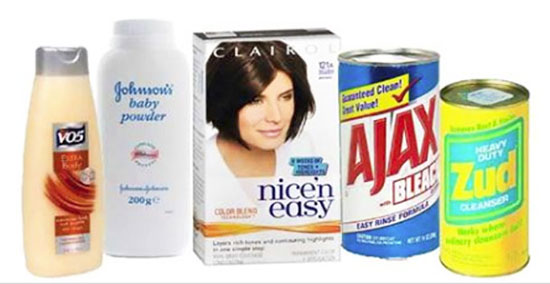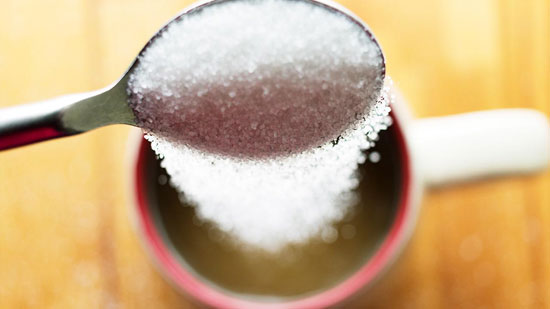Cancer Causing Products Which Are Found in Your Home!

Our lifestyles have changed significantly due to the technology development and modern society. We constantly use harmful toxins and chemicals, consume genetically modified foods and breathe polluted air.
Moreover, we aren’t usually aware that the products we use are harmful, since labels are making everything to hide that.
In this article, we present you the most harmful products which often cause cancer and that are found in your home.
1. Whole milk (Lucerne or Borden)
There are toxic ingredients in this product, and they are unlabeled:
– Antibiotics – these contribute to resistance and allergies and some are also carcinogenic.
– Heptachlor – carcinogenic, xenoestrogen, neurotoxic element and causes reproductive toxicity.
– Dieldrin – xenoestrogen, carcinogenic.
– Hexachlorobenzene – it is neurotoxic element, causes reproductive toxicity and carcinogenic.
– DDT – xenoestrogen, carcinogenic.
– IGF-1 and rBGH – these cause prostate, breast and colon cancer.
2. Ajax Cleanser
There is Crystaline Silica in this product. It is a toxic ingredient and it is not labeled. Furthermore, this ingredient causes cancer and lung, eye and skin irritation as well. The Material Safety Data Sheet proved that this ingredient is toxic since 1994, and they have reduced its usage as well.
3. VO5 Hair Conditioning
This product contains the following labeled toxins:
– FD&C RED – it can trigger cancer development.
– Fragrance – it can cause dermatitis.
– Formaldehyde – it is neurotoxic, carcinogenic and can cause dermatitis.
– Polysorbate 80 – it is poisoned with p-dioxane.
4. Flea Collar by Zodiac
There is a label toxic ingredient in this product, known as Propoxur and it is neurotoxic and carcinogenic.
5. Talc Powder
Talc is the ingredient which is harmful. It contributes to ovarian cancer and lung irritations.
6. Foundation Make-up (Cover Girl)
There are labeled toxins, such as:
– Parabens, which cause dermatitis.
– Triethanolamine – when combined with nitrites, leads to carcinogenic nitrosamines.
– Talc – might cause cancer and lung irritation.
– Fragrance – unlabeled and untested ingredient, which may lead to dermatitis.
– Bha – this ingredient is carcinogenic.
– Lanolin – it is poisoned with DDT and carcinogenic pesticides.
7. Beef Frankfurters
This product has a lot of unlabeled toxic ingredients, including:
– Hormones – feminizing and carcinogenic.
– Antibiotics – they can contribute to drug resistance or allergies, and are also carcinogenic.
– Hexachlorobenzene – teratogenic, carcinogenic and neurotoxic.
– Lindane – stops blood cells formation, carcinogenic and neurotoxic.
– Benzene hexachlorid – this substance is carcinogenic.
– DDT – xenoestrogen and carcinogenic.
– Heptachlor – carcinogenic, neurotoxic, reproductive toxin and xenoestrogen.
– Dachtal – irritant, strong sensitizer, carcinogenic, and might contain dioxin.
– Dieldrin – carcinogenic and xenoestrogen.
Nitrite is a labeled toxic ingredient, and if mixed with heterocyclic amines it might cause cancer in kids.
8. Disinfectant Spray (Lysol)
This contains unlabeled and labeled toxic ingredients. OPP, i.e. Ortho-phenyphenol is carcinogenic and leads to irritations.
9. Clairol Nice & Easy (a permanent hair color)
Some of the labeled toxins are:
– Fragrance – causes non-Hodgkin’s lymphoma, multiple myeloma and other cancer types. It also causes dermatitis.
– Propane-1, 2-diol – caused dermatitis.
– Phenylenediamine – causes contact dermatitis and it carcinogenic.
– Quartenium 15 – it is carcinogenic, sensitizer, neurotoxic, contact dermatitis and releases formaldehyde.
– Diethanolamine or DEA – if mixed with nitrite ions it creates carcinogenic nitrosamine.
10. Weed Killer (Ortho)
Sodium 2, 4-dichlorophenoxyacetate is a labeled toxic compound. It is neurotoxic, reproductive toxin, and carcinogenic. It can cause soft tissue sarcoma, lymphoma, and other types of cancer.
11. Heavy Duty Cleaner
Crystalline silica is unlabeled ingredients and it is carcinogenic. It causes skin, lung and eye irritation.
12. Non-Stick Cookware
Non-stick cookware is by far the most common cookware used by westerners, yet there is an adverse side effect they have on our health. They are proven to release toxic chemicals into food during cooking. When non-stick cookware is heated up, its coating begins to break down at a molecular level.
When the coating breaks down it releases a variety of toxic particles and fluoride-based gasses, many of which are carcinogenic (cancer causing). Instead of toxic non-stick cookware, purchase glass or ceramic pots and pans that don’t release harmful fumes.
13. Artificial Sweeteners
Many people think that they are doing their body justice when swapping sugar for one of its alternatives. Although there are many healthy natural sweeteners out there, the most commonly used ones tend to be a lot worse for you than sugar. If you have any of the following sweeteners, throw them out immediately:
• Acesulfame K may be carcinogenic, causes tumors and affects pregnancy;
• Aspartame has been linked to skin cancers and can be deadly for people with phenylketonuria;
• Saccharin may cause bladder cancer, is indigestible and gets excreted by the liver unchanged;
• Sorbitol, is only partially digested in the intestines, causes diarrhea, bloating and gas.

Instead, replace these artificial sweeteners with ones that can be naturally found and cultivated without refining. This includes:
• Stevia can lower blood pressure and blood sugar;
• Erythritol has no effect on blood sugar, insulin or cholesterol levels;
• Xylitol can improve bone density and reduce risk of tooth decay;
• Yacon syrup feeds good bacteria in intestines and can help fight against constipation.
14. Plastic Bottles And Food Containers
When you drink liquid or eat food from containers made out of plastic, the chemicals in that plastic leach into whatever you are putting in your mouth and eventually gets digested in your body along with it. Among these chemicals are Bisphenol A, which is used to harden plastic in products such as water bottles.
Many studies have linked Bisphenol A to having adverse health effects. In 2010 the FDA changed their stance on the chemical, expressing “some concern” over its effects on the brain, behavior and prostate glands in fetuses, babies, and young children.
Instead of using disposable plastic water bottles, opt for reusable metal or glass ones. The same goes for food containers. Not only are you saving the environment, but you’re keeping your body safe as well.
15. Air Fresheners
Air fresheners are often advertised as being able to rid your house of pungent odors and noxious gas. However, recent research suggests that the fumes emitted from air freshener cans are actually more dangerous than cigarette smoke. These fumes have also been found to cause many health problems:
• Respiratory conditions such as asthma;
• Hormone imbalance;
• Cancers – One study showed that common air fresheners contain a “considerable” amount of formaldehyde, which the United States classifies as a “known human carcinogen”. Overexposure to air fresheners has been linked to cancers of the nose and throat.
A natural alternative to conventional air fresheners is the use of essential oils. Not only are they effective at creating pleasant aromas, but they have also been proven to be able to provide numerous health benefits as well. One study found that inhaling rosemary oil could improve your mood and stimulate the nervous system.
To use essential oils as an air freshener, add 10 to 15 drops of essential oil into a spray bottle with approximately one cup of distilled water. Spray this around the house as you would a conventional air freshener.
16. Commercial Cleaning Products
The average household usually has a variety of cleaning products for many different parts of the house. Although cleaning substances are necessary to keep your house free from the build up of harmful bacteria, most commercial cleaning products have been linked to many health problems, such as:
• Respiratory disorders and asthma;
• Hormone disruptors – Studies found that these cleaning products include substances such as parabens, triclosan, phthalates, and BPA.
Thankfully, vinegar and baking soda provide natural antimicrobial cleaning properties without the same side effects as commercial cleaners. One study found that they were effective against a variety of bacteria including staph, salmonella, and E.coli.
17. The Humble Toothpaste
Unfortunately, the innocent looking toothpaste found in a regular household holds many scary secrets! With ingredients such as Saccharin and Fluoride, both carcinogens (cancer causing), toothpaste is not something you would want anywhere near your mouth.
Saccharin – an artificial sweetener, mentioned above. It is said to be approximately 350 times sweeter than sugar. Considered to be a human carcinogen, so it’s something to keep away from!
Fluoride – Another human carcinogen, fluoride can have a myriad of unhealthy effects; from causing cavities to severely damaging your thyroid. Find out how using coconut oil could be the healthy alternative to supermarket toothpaste you never even thought of.
18. Shampoo
Anti-dandruff shampoo like Head & Shoulders “Dry Scalp 2-in-1” product contain methylchloroisothiazolinone, which is a suspected mutagen. They also contain ammonium laureth sulfate, which, although won’t cause any health problems on its own (apart from stinging if it gets in your eye), can sometimes be contaminated during the manufacturing process such as 1,4-dioxane. Early rat studies found that this contaminant causes cancer, and the U.S. Department of Health and Human Services has said it’s reasonably anticipated to be a human carcinogen as well.
19. Mothballs
There certainly is a reason they prevent your clothes from getting eaten by moths – they’re highly toxic! Containing an ingredient called Naphthalene, these innocent looking balls can cause many healthy problems, such as:
• Kidney and liver damage;
• Hemolytic Anemia (it destroys red blood cells!);
• Can cause cancer in animals – so keep them well away from pets! This means it has been labeled a human carcinogen, but there is no sound proof that they are directly linked to one another.
20. Antibacterial Soap
Antibacterial soap certainly sounds like it’s going to do what it says – get rid of bacteria and nasty germs! However, studies by the FDA have shown that these soaps contain an ingredient called Triclosan, which:
• Interferes with hormone levels in animals;
• Spurs the growth of drug-resistant bacteria;
• Increases risk of infertility, early puberty, and cancer.
Avoid using chemical ridden soaps and opt for a more natural approach. This homemade soap is a great way to avoid Triclosan and any other unwanted chemicals found in antibacterial soap.
21. Flea and Tick Treatment
You might think you’re helping your beloved pooch out, but unfortunately, flea and tick treatments may be more harmful than helpful! Tests on laboratory animals have shown an enormous amount of problems with the substance Fipronil, found in many liquid fleas and tick treatments. This product can cause:
• Vomiting or diarrhoea;
• Mild skin irritation;
• Weakness;
• Headaches;
• Seizures and dizziness;
• Considered a “possible human carcinogen”.
Research the internet and discover all-natural ways to prevent your pets from getting fleas or ticks.
So if you haven’t done it already, get to it! Ditch these common household products to prevent so many health problems that you could do without.
yogaesoteric
December 4, 2018
